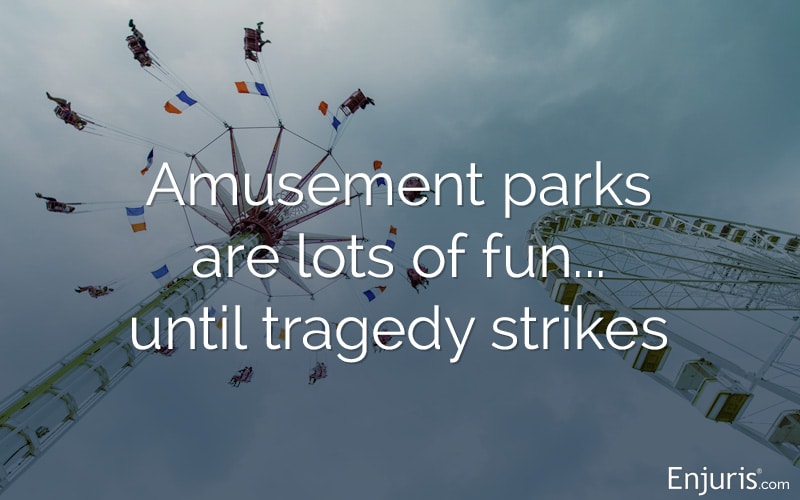
There are few things more wholesome than a day at the amusement park. Many of us have childhood memories of sweaty summer days with a cotton candy in one hand and a soda in the other, waiting on line for the newest and greatest roller coaster or other attraction.
And while millions of people continue to enjoy amusement parks every day, leaving with smiles and memories, we hear every so often about a tragic amusement park accident.
On March 24, 2022, Missouri teen Tyre Sampson was visiting ICON Park in Orlando. He chose to ride the FreeFall, a ride that hoists individually seated passengers to 400 feet off the ground. Once in the air, a rider’s gondola seat will tilt forward at a 30-degree angle and is then released, plummeting at a speed of 75 miles per hour. The ride then brakes at 100 feet above ground. Each rider is secured in their seat by a harness.
How did this fun day at ICON Park turn tragic?
But Tyre Sampson wasn’t secured in his seat. In fact, his harness had been manually adjusted because the teen was more than six feet tall and weighed around 380 pounds.
The ride apparently had a 287-pound rider limit, but no staff member questioned Tyre’s weight or said that he might not be safe on the ride. In fact, a safety sensor was manually adjusted to allow for his size. Moments after the ride began its 400-foot drop toward the ground, Tyre slipped from his seat and plummeted to his death. Because the harness had been adjusted, there was a larger gap than normal between Tyre’s harness and the seat. However, the gap improperly satisfied the electronic safety sensor on the ride, which allowed the ride to begin even though his seat fastener was unsafe.
A post-accident report indicated that the ride’s attendants had not been properly trained on the weight requirements or loading procedures. They were under the impression that if the sensor light was on, the ride was safe. The person who checked Tyre’s seat had been on the job for three days and was a trainee at the time of the accident.
Sampson family wrongful death lawsuit for Tyre’s death
Tyre’s family filed a wrongful death lawsuit against several defendants, including ICON Park, ride operator Slingshot, Austrian ride manufacturer Funtimes Handels and German ride chair manufacturer Gerstlauer Amusement Rides. The family settled the lawsuit against ICON and Slingshot for an undisclosed sum.
On December 5, 2024, a Florida jury ordered Funtimes Handels to pay $155 million to each of Tyre's parents. The trial lasted just one day, as Funtime did not appear in court to defend itself.
The family's attorneys, Ben Crump and Natalie Jackson, called the verdict a victory for accountability, stating, "Tyre's death was the result of blatant negligence." They pointed out that a seat belt could have been added to the ride for just $660.
About a year after Tyre’s death, the ride was disassembled and removed from the park.
Who’s liable for amusement park injuries?
Tyre’s death raised some important questions about premises liability, and particularly amusement park injuries.
Thousands of people are injured in amusement park accidents each year in the United States. About ⅓ of them are injured on roller coaster rides. Any ride that takes a passenger high above the ground, goes upside down, or moves fast has the potential to be dangerous.
There are several ways that these types of accidents can happen:
- Mechanical failures. Mechanical failures include things like missing safety pins, broken welds or structural components, exposed electrical wires, broken drive chains, and malfunctioning lap bars.
- Operator behaviors. Operator behaviors that cause roller coaster accidents include abruptly stopping the ride, improperly assembling or maintaining the ride, and ignoring safety procedures.
- Passenger behaviors. Passenger behaviors that cause roller coaster accidents include intentionally rocking cars, standing up, defeating safety restraints, and sitting improperly.
- Inherent dangers. Even when nothing goes wrong, certain roller coasters, such as those with sudden drops, can cause injuries like loss of consciousness, headaches, and dizziness.
In these types of instances, the plaintiff (injured person) would likely seek to hold someone liable for negligence, or the failure to exercise reasonable care. In an amusement park setting, these are some common examples of negligence:
- Failure to post or enforce warning signs
- Failure to properly train ride operators
- Failure to maintain and inspect equipment for safety
- Failure to react to an emergency situation
These types of accidents usually fall under the category of premises liability law. This is the area of law that holds an owner or manager liable for injuries to people who are lawfully permitted to be on the property.
However, as we saw in Tyre Sampson’s case, there could be multiple liable parties, including equipment manufacturers. It’s not always straightforward, which is why it’s essential to seek the advice of a qualified, experienced personal injury lawyer if you or a family member have been injured.
Further, Florida is a pure comparative negligence state. That means a plaintiff’s damage award could be reduced according to their percentage of fault if they’re found to have even a small role in their own injury. Even if the person didn’t cause the accident, the court could find that they might have acted differently in a way that would have prevented it.
If you or a family member was injured while visiting an amusement park, or if your family experienced a horrific tragedy like what happened to Tyre Sampson, there is help available. The team at the Redondo Law Firm is dedicated to helping people like you seek justice and reach compensation after a personal injury accident of any kind, any time.
Disney Faces Lawsuit Over Alleged "Injurious Wedgie" Incident at Water Park
A woman injured at Typhoon Lagoon water park in Florida filed suit against Walt Disney Resort after experiencing an injurious wedgie.


